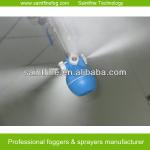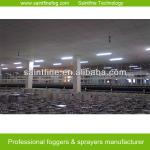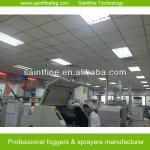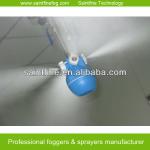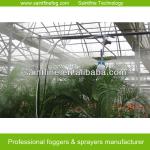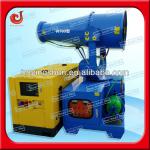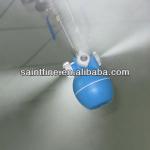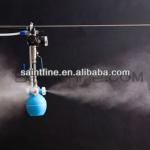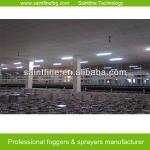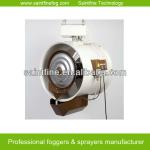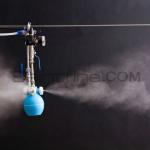Popular 100W Industrial Portable ultrasonic Wave Humidifier
| Condition:New | Place of Origin:Zhejiang China (Mainland) | Brand Name:Cheersonic | Model Number:CSA |
| Voltage:220V/110V | Weight:4KGS-10KGS | Warranty:3 Years | Material:Aluminum |
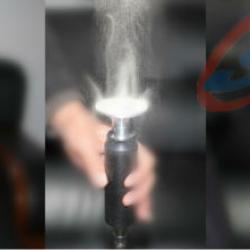
Popular 100W Industrial Portable ultrasonic Wave Humidifier
TYPICAL APPLICATIONS
- Coating non-woven fabric, paper, etc.
- Laboratory spray drying
- Injecting moisture into a gas stream
- Applying minute amount of oil, fragrance or flavor onto a product
- Injecting small volume of reagents into a reactor
FEATURES
- . Reduce material consumption
- Non wasteful overspray
- Very low flow rate capabilities, inter-mitten or continuous
- Non clogging
- Corrosion resistant
- High precise and highly controllable
- Low cost spray nozzle replacement
- GENERAL DESCRIPTION
Unlike conventional atomizing nozzles that rely on pressure and high-velocity motion to shear a fluid into small drops, the ultrasonic atomizer uses only ultrasonic vibrational energy to generate a gentle, low-velocity spray. Overspray is practically eliminated, resulting in substantial material savings and reduction in airborn pollution. The liquid can be dispensed to the atomizing probe (nozzle) by either gravity or a small low-pressure metering pump, and atomized continuously or intermittently. The rate at which the liquid is atomized depends, within limits, solely on the volume that is being delivered onto the atomizing surface, and the frequency.
Typically, the higher the frequency, the lower the processing capability. The amount of material atomized can be as little as 2 μl/sec. Because the droplets typically drift downward at low velocity under the influence of gravity, the probe should be mounted with the tip facing downward, and air turbulence kept to a minimum to mitigate spray pattern distortion. A wide variety of coatings, chemicals, lubricants, and particulate suspensions can readily be atomized.
However, factors such as viscosity, miscibility, and solid content deserve consideration. For optimum atomization, the viscosity should be under 100 cps and the solid concentration kept below 30%. Although lower frequencies are capable of atomizing higher viscosity liquids, because the atomization process depends on setting a liquid film into motion, typically the higher the viscosity – the lower the flow rate, and the more difficult the application. The atomization of liquids containing long-chained polymer molecules is problematic, even in diluted form, due to the highly cohesive nature of the material
In many cases, mixtures with particulates can be atomized, because the solids are simply carried along in the drops. The low transport velocity of the liquid through the probe permits even abrasive slurries to be processed with negligible erosion of the passageway. Compared with conventional pressurized nozzles, the feed channel running through the probe and exit orifice are relatively large, and practically uncloggable. Drop size is primarily a function of frequency, and the higher the frequency, the smaller the drop diameter. With water, the median drop size at 20 kHz is 90 microns, and 50 microns at 40 kHz.
- HOW DOES IT WORK?
The ultrasonic power supply converts 50/60 Hz to high frequency electrical energy. This electrical energy is transmitted to the piezoelectric transducer within the converter, where it is changed to mechanical vibrations. The ultrasonic vibrations are intensified by the probe and focused at the tip where the atomization takes place. The liquid travels through the probe, and spreads out as a thin film on the atomizing surface. The oscillating tip disintegrates the liquid into micro-droplets, andejects them to form a gentle, low velocity spray.
- SPECIFICATIONS
Ultrasonic Spray | |||||||
| TYPE | CSA15 | CSA20 | CSA30 | CSA40 | CSA50 | CSA55 | |
| Frequency (khz) | 15 | 20 | 30 | 40 | 50 | 55 | |
| Median drop size ( μm) | 120 | 90 | 70 | 50 | 40 | 25 | |
| Power (W) | 500 | 200 | 150 | 130 | 100 | 30 | |
| Handling capacity(L/H) | 150 | 70 | 35 | 10 | 2 | 2 | |

| Packaging Detail:carton |
| Delivery Detail:7 working days |



